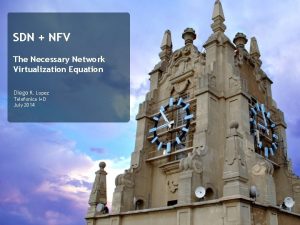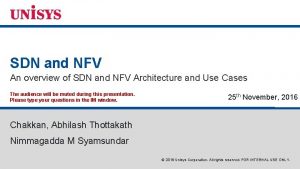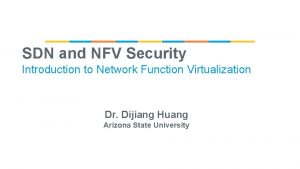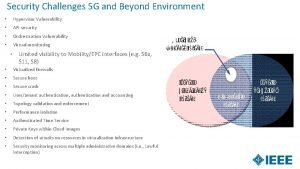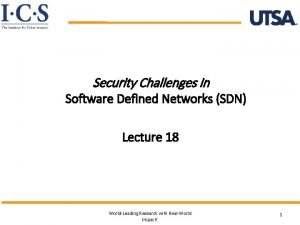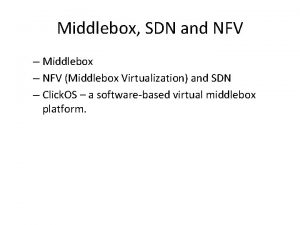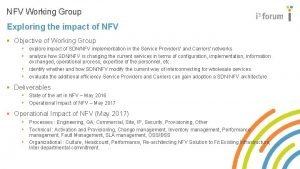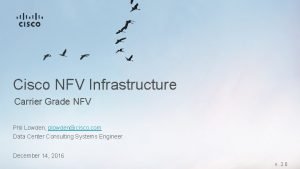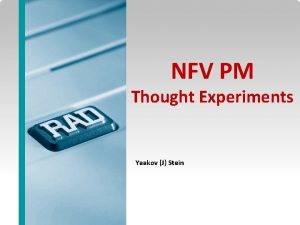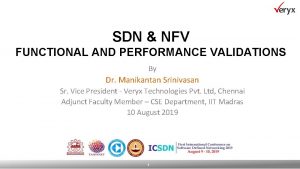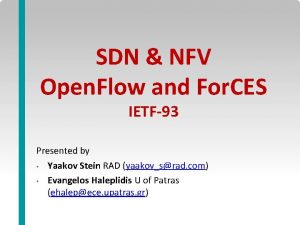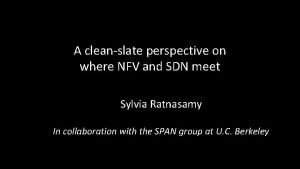SDN and NFV Security Core Concepts of SDN














- Slides: 14

SDN and NFV Security Core Concepts of SDN Dr. Dijiang Huang Arizona State University

Problems of Computer Networks? | Networks used to be simple: Ethernet, IP, TCP…. | Many complex functions backed into infrastructure - OSPF, BGP, multicast, differentiated services, traffic Engineering, NAT, firewalls, … | For example, new control requirements led to great complexity - Isolation - Traffic engineering - Packet processing - Payload analysis - …. . VLANs, ACLs MPLS, ECMP, Weights Firewalls, NATs, middleboxes IPS, Deep packet inspection (DPI)

Software Defined Networking (SDN) Definitions | SDN is an approach to building computer networks that separates and abstracts elements of these systems. – from Wikipedia | In the Software Defined Networking architecture, the control and data planes are decoupled, network intelligence and state are logically centralized, and the underlying network infrastructure is abstracted from the applications. - from ONF White Paper

Two “Planes” of SDN Processing Plane Where it runs How fast these processes run Type of processes performed Control Plane Switch, router CPU (smart but slow) In the order of thousands of packets per second Routing protocols (i. e. , OSPF, IS-IS, BGP), Spanning Tree, SYSLOG, AAA (Authentication Authorization Accounting), NDE (Netflow Data Export), CLI (Command Line interface), SNMP Data Plane Dedicated Hardware ASIC (fast but dumb) Millions or Billions of packets per second Layer 2 switching, Layer 3 (IPv 4 | IPv 6) switching, MPLS forwarding, VRF Forwarding, QOS (Quality of Service) Marking, Classification, Policing, Netflow collection, Security Access Control Lists

How to Simplify the Networking Problem? | How to get a simpler, more systematic design for the so complicate network control mechanisms? | The power of Abstraction - “Modularity based on abstraction is the way things get done. ” --Barbara Liskov | Abstractions Interfaces Modularity Composability Simplification Interoperability Separation

SDN Abstractions | SDN is defined precisely by three abstractions: Forwarding, Distribution, Configuration - Abs#1: Be compatible with low-level hardware/software • Need an abstraction for general forwarding model • • Open. Flow is current by default the forwarding standard Configuration in terms of flow entries: <header, action> - Abs#2: Make decisions based on entire network • Need an abstraction for distributed network state • • Global network view abstraction Network OS (controllers) queries network devices to form “view” and sends commands to them to control forwarding - Abs#3: Compute the configuration of each physical device • • Need an abstraction that simplifies configuration Network virtualization: map abstract configuration to physical configuration

Traditional Control Mechanisms | Distributed algorithm running between neighbors - Complicated task-specific distributed algorithm

From Traditional Networking to SDN App App App view Network Operating System App App Operating System App Packet Processing Operating System Packet Processing App App Operating System Packet Processing App Global view

Abstract SDN Model Application Tier Control Plane Tier (Network OS) Data Plane Tier Northbound Interfaces App App Network Virtualization Network Operating System Southbound Interfaces Open interface to hardware Simple Packet Processing: forwarding Simple Packet Processing: forwarding

SDN Compiles to topology Transmits to switches Control Program Abstract Network Model Network Virtualization Global Network View Network OS Virtualization Configuration Specific behavior routing, access control, etc.

How to Process the SDN Requests? | Write a simple program to configure a simple model - Configuration merely a way to specify what you want | Examples - ACLs: who can talk to who - Isolation: who can hear my broadcasts - Routing: only specify routing to the degree you care • Some flows over satellite, others over landline - TE: specify in terms of quality of service, not routes | Virtualization layer “compiles” these requirements - Produces suitable configuration of actual network devices | NOS then transmits these settings to physical boxes Abstract Network Model Network Control. Virtualization Program Global Network View Network OS

Clean Separation of Concerns | Control program: express goals on abstract view - Driven by Operator Requirements | Virtualization Layer: abstract view global view - Driven by Specification Abstraction for particular task | NOS: global view physical switches - API: driven by Network State Abstraction - Switch interface: driven by Forwarding Abstraction

SDN Tiers | Data Plane Tier - Packet forwarding (as per flow table), packet manipulation (as per flow table), statistics collection | Control Plane Tier (Network OS) - Data plane resource marshaling, common libraries (e. g. , topology, host metadata, state abstractions) | Application Tier - Virtual network overlays, network slicing (delegation), tenant-aware broadcast, application-aware path computation, integration with other software packages, policy, security, traffic engineering.

Wrap-Up
 Which application
Which application Nfv vs sdn
Nfv vs sdn Nfv
Nfv Sdn nfv certification
Sdn nfv certification Sdn nfv
Sdn nfv Security security security
Security security security Sdn concepts
Sdn concepts Sdn security challenges
Sdn security challenges A company's resources and capabilities represent
A company's resources and capabilities represent Marketing creating and capturing customer value
Marketing creating and capturing customer value Inner core and outer core
Inner core and outer core Inner core and outer core
Inner core and outer core Purpose of paradox
Purpose of paradox Food security concepts and frameworks
Food security concepts and frameworks Core concepts of management
Core concepts of management
